Psychology Review: Chapter 4
1/39
There's no tags or description
Looks like no tags are added yet.
Name | Mastery | Learn | Test | Matching | Spaced |
|---|
No study sessions yet.
40 Terms
What is the 2-step process to register images
Sensation: "raw" images and thoughts from sensory organs (eyes, ears, skin, nose, and tongue)
Perception: translation of the brain (electrical signaling)
What does the (stimulus) mean to us
Sight, smell, touch, sound, and taste
How does the brain respond to stimulus?
Perception and transduction
Translational process of stimulus: transduction
After we receive electrical sense, but before action
How is our sensory system able to detect stimulus?
Just noticeable difference (JND)
Weber’s Law
Absolute Threshold
Signal Detection Theory
What is the initial detection for our sensory system?
Through absolute threshold
Lowest level of stimulus to acknowledge something
After initial detection, then how much of a difference needs to occur in order for us to notice a difference happened?
Just noticeable difference (JND): smallest detectable change in stimulus intensity
Weber's Law: what was the initial intensity? Because then it would dictate JND
What dictates a JND?
The initial intensity of stimulus (Weber's Law)
Low JND: a lot of background stimulus that affects initial reaction
High JND: not a lot of background stimulus that can affect initial reception
How can you detect a signal depending on its context?
Signal detection theory: the accuracy of detecting signal under uncertain conditions
Signal to noise ratio; discovering when someone accurately notices the signal
What is the significance of response bias?
It will determine the frequency of false negatives to false positives
Can help researchers find out if people are more likely to respond positively when in uncertain positions or respond negatively
What are the types of response bias in signal detection theory?
Hit
Miss (false negative)
Correct rejection
False Alarm (false positive)
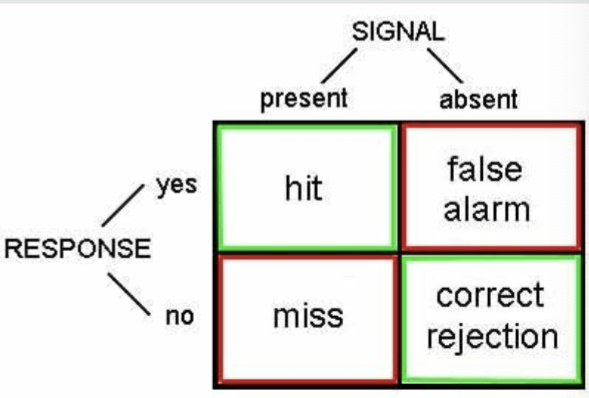
What is the role of attention in sensation?
A person's selective nature impacts what they will focus on (i.e. "locking in")
What is the filter theory of attention?
We can intentionally focus on some and ignore a few
What are models of selective attention
Cocktail party effect: there will always be another unconscious variable that will take over your attention once it becomes relevant (i.e. someone says your name at a party from across the room when you're in conversation with someone else)
Intentional: when you don't realize something obvious appears
i.e. an apple shows up out of nowhere, but you didn't know it showed up
Change: you don't realize a change has occurred, b/c of selective attention
Given something to put your attention to, but you don't realize a change has happened
What is working memory?
What you are working/focusing on at that moment
Explain transduction?
Sensory stimuli are converted into neural signals that can be interpreted by the brain
What are the major components of the ear?
Outer Ear
Middle Ear
Inner Ear
What are the parts of the outer ear and what are their functions?
Where the sound waves are caught
Pinna: the part of the ear we actually see (catches sound waves)
Auditory/Ear canal: funnels sound waves to the middle ear
Ends at the eardrum
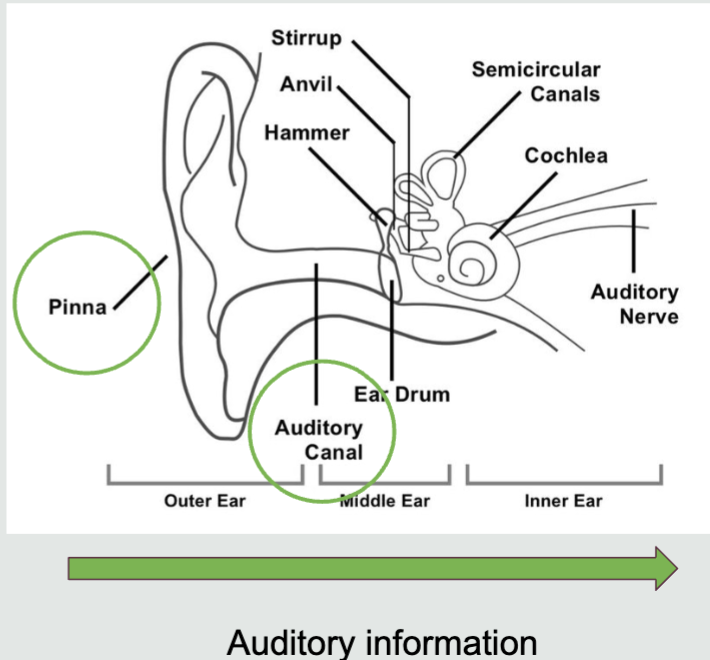
What are the parts of the middle ear and what are their functions?
The eardrum: bounces sound waves to the inner ear
Ossicles (tiniest bone in the human body): works with vibrations
Hammer
Anvil
Stirrup
Vibrations push the sound inwards
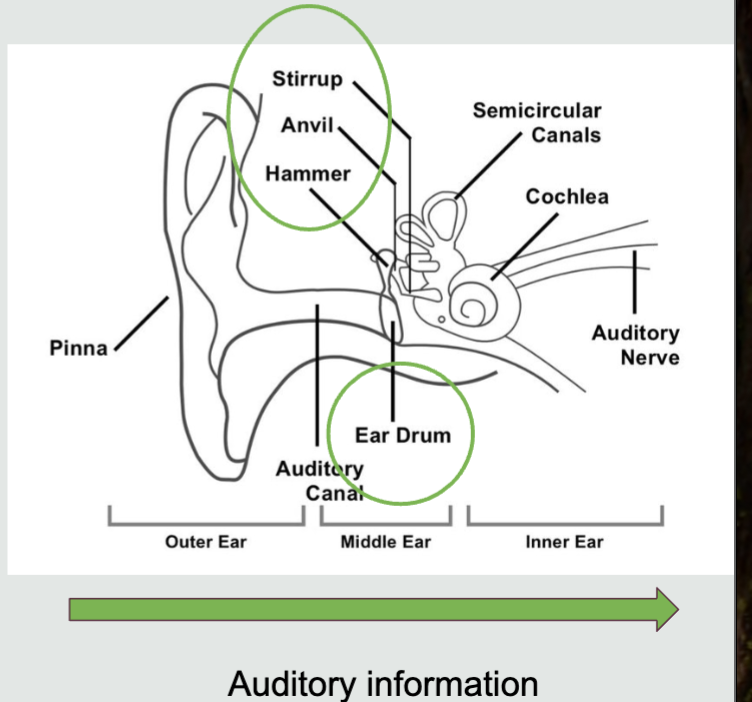
What are the semicircular canals?
three fluid-filled, loop-shaped tubes in the inner ear
detect and relay information about head rotation and balance to the brain, enabling stable vision during movement
What are the parts of the inner ear?
Cochlea: converts soundwaves to something recognizable (smaller parts assist in transduction)
Basilar membrane
Organ of corti
Auditory nerve: carries action potentials to the thalamus (after transduction)
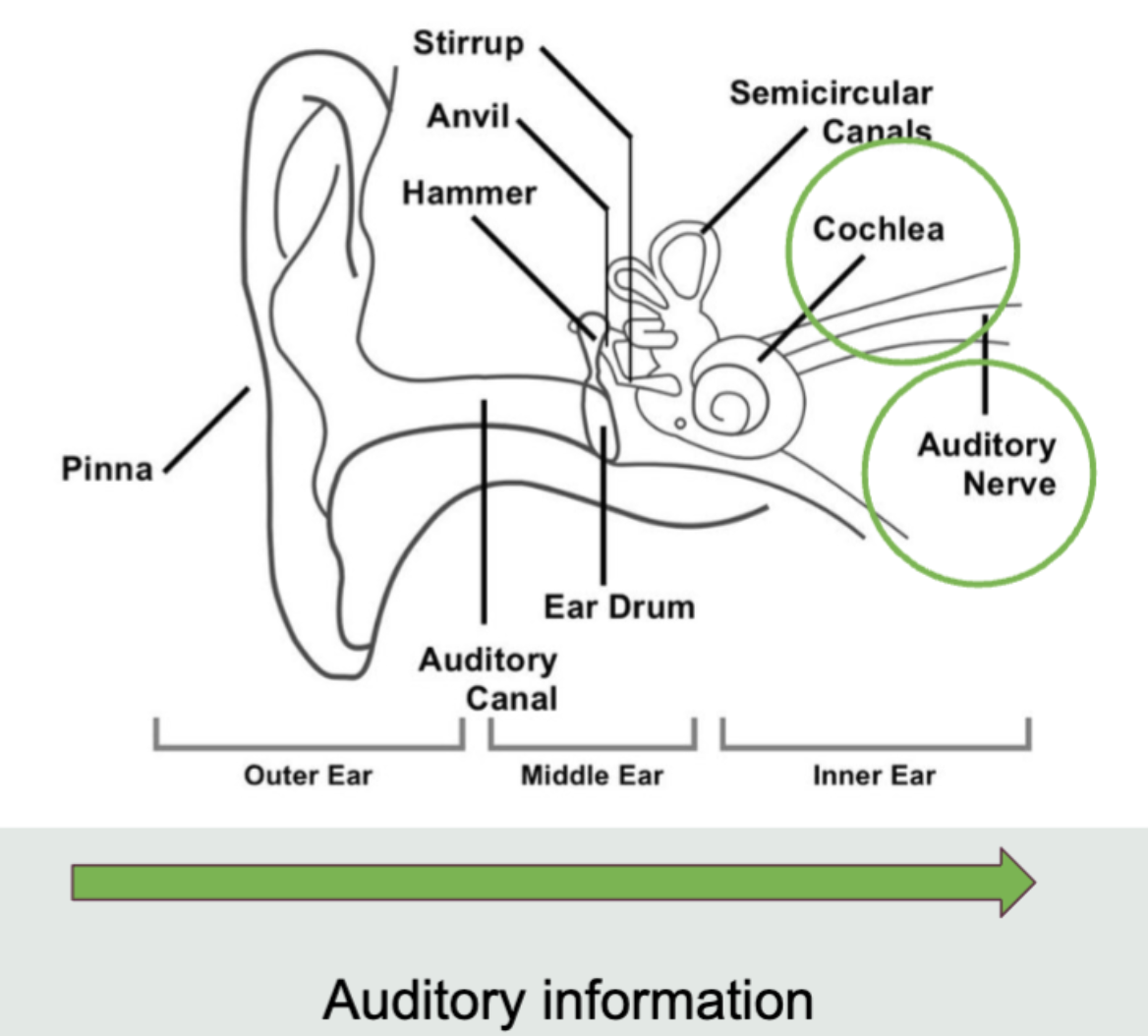
What are the different categories for deafness?
Conductive deafness: caused by malfunctioning with the ear structure
Nerve deafness: even if the sound waves reach the ear, the auditory nerve is unable to receive and understand the information
Noise-induced hearing loss: caused by constant exposure to loud noises (leads to damage of hair cells)
Interferes with transductions
Once they are damaged they will be damaged permanently
What are the theories of pitch perception for low and high tones?
High-pitch (5,000-20,000 Hz): place theory
Low-pitch (20-5,000 Hz): frequency theory and volley theory
How is place theory utilized?
Looks at the cochlea in the basilar membrane
Where the transduction in the basilar membrane occurs dictates where in the brain the information is going to be processed (1:1 relationship)
Similar to functional scans
How is frequency theory used?
Looks at how the neurons are fired in accordance with transduction process (up to 100 Hz)
similar to fMRI scan b/c of correlation between frequency and placement
States that depending on how quickly action potentials are firing determines the pitch
What is volley theory?
Neuron sets fire out of sync to reach a cumulative speed that matches the pitch (100-5,000 Hz)
Give and take process
What are the parts of the eye and their significance?
The brain only computes the immediate reaction and will send that stimulus to the brain and its neurons
Pupil: point of light entrance
Iris (muscle): controls entrance of light (dilation/constriction)
Cornea: focuses visual image on retina (assists in the light/stimulus recognition via externally)
Lens (works in partnership with the cornea): internal counterpart of cornea; changes shape to achieve
Retina: where transduction takes place (translation)
Rods
Cones
Optic Nerve
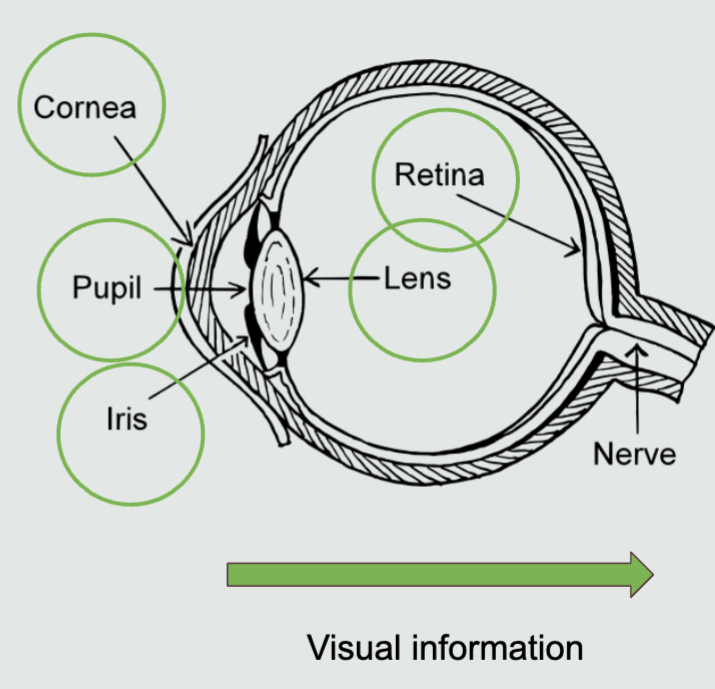
What is the significance of the retina?
Rods: helps with low light conditions
Operates in the peripheral
Cones: color vision and details in high light conditions
operates with apparent images
What parts of the eye assists in transducing light waves and filtering to the brain?
Retina
Optic nerve: corresponds with the blind spot
Optic chiasm: where the optic nerve axon crossover occurs, so the registering of images from the right eye occurs in the left side of the brain (vice versa)
What are the theories for color visions?
Trichromatic theory (Young-helmholtzs theory)
Opponent process theory
Explain trichromatic theory?
looks at how we respond to different types of light
There are 3 cones, which detects 3 primary colors (R, G, B)
Those with all 3 cones are called trichromats
Without all 3 means that they have a very limited perspective
Explain opponent process theory
Addresses of other nuances
Color is perceived in 3 pairs of opponent cells (why we see after-images)
red v. green
blue v. yellow
black v. white
What are the different categories for vision deficiencies?
blindness
blindsight
visual agnosia
When is someone considered blind/has blindness?
Relates to the actual structure of a person's eye
They completely lack visual ability or score <20/200 on Snellen eye chart
What is blindsight?
Relates to neural functions
When a person has damage to their occipital lobe, but can still make correct guesses about their environment
What is visual agnosia?
Brain-related deficiency
It is a perceptual issue, due to a lack of recognition (can describe something, but not label)
What is the significance of the limbic system?
emotional nervous system in the brain
Functions/Ties
Olfaction (smell): airborne chemicals connect with specific receptors in nasal passages (lock-and-key concept)
Taste (gustation)
Papillae (contain taste buds)
Emotion
How is our perception of touch and pain relative?
Gate control model
when pain is blocked from consciousness due to circumstances
Phantom limb syndrome
when a person feels pain in an area that no longer exists
How does facial perception work?
Faces are processed holistically (from the temporal lobe to FFA)
The inability to recognize faces are prosopagnosia
How are the gestalt principles apparent in our daily lives?
Discusses how we perceive objects as wholes within their overall context (i.e. chiaroscuro shows different images based on what you see first)
Principles:
Proximity, closure, figure-ground, symmetry, continuity, and similarity
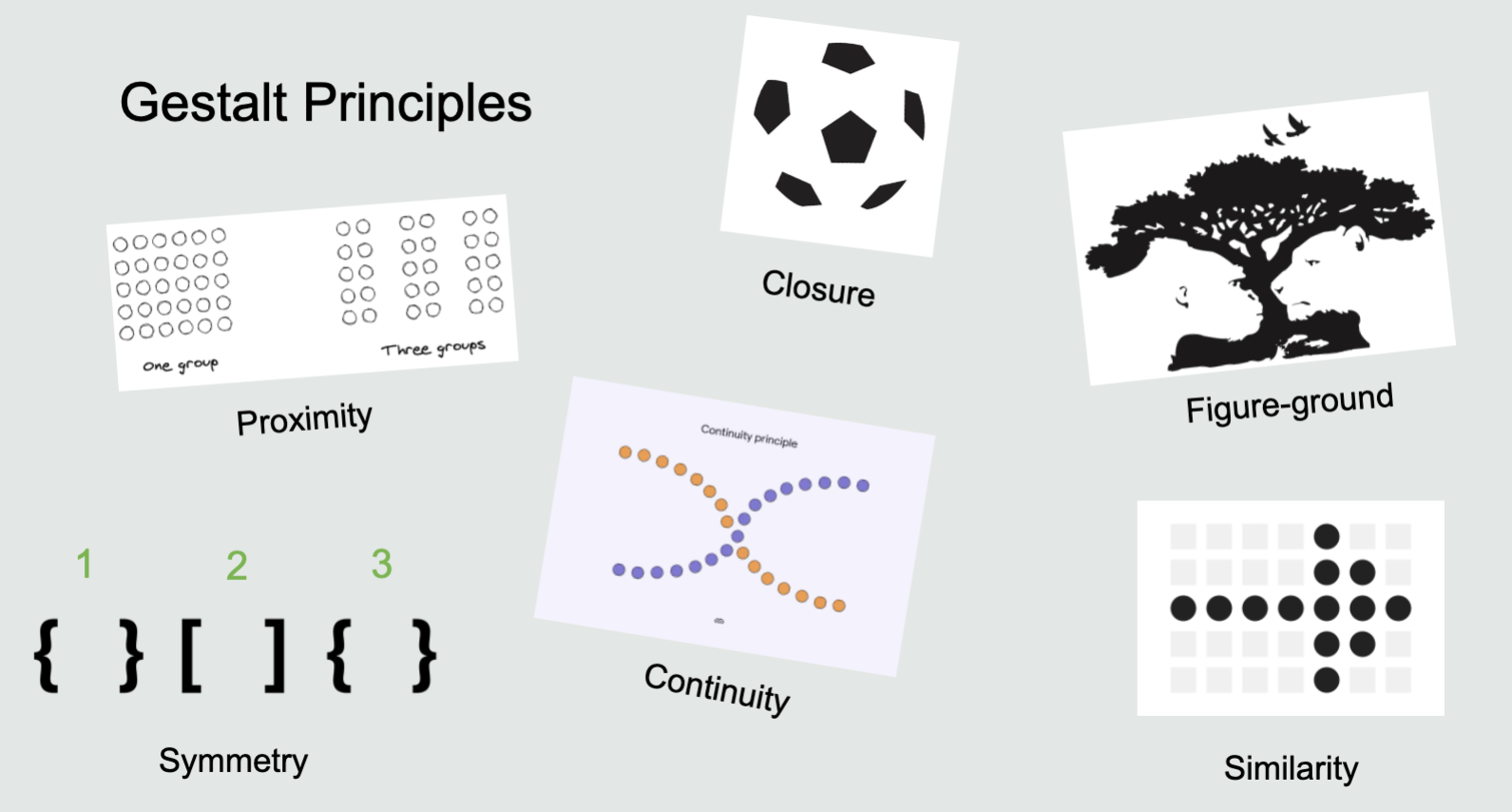
What is the significance of perceptual constancy?
Observing stimuli consistently across different conditions
Based on shape, size, and color
Door differences showcase how our brain understands objects on the basis of shape, size, and color (shadowing)
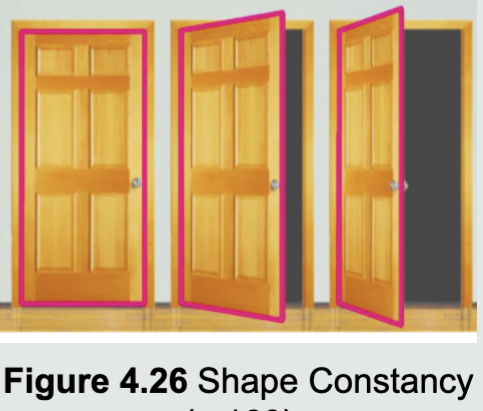
Explain the cocktail party theory?
refers to our ability to focus our auditory attention on a particular stimulus while filtering out background noise
while we use selective attention to focus on this stimulus, our brain monitors other stimuli at a low level
shows that other stimuli are not blocked but rather not prioritized